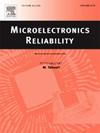非均匀热源三维集成电路中TTSV布局优化的模拟退火算法
IF 1.9
4区 工程技术
Q3 ENGINEERING, ELECTRICAL & ELECTRONIC
引用次数: 0
摘要
随着三维集成电路(3d - ic)集成度的提高,热管理变得越来越重要。在3d集成电路中插入热通硅孔(TTSV)被认为是解决散热问题的有效方法。本文提出了一种考虑TTSVs分布的优化模拟退火(OSA)算法。该算法考虑了非均匀热源下TTSV分布对3d - ic热分布的影响。在3D-IC的全局仿真中,该优化算法可以有效降低3D-IC的温度。用COMSOL软件对算法进行了仿真,结果与前面的计算结果吻合。仿真结果表明,在单层和四层芯片模拟中,采用OSA算法的TTSVs分布的峰值温度分别比均匀分布降低了1.78 K和1.2 K。因此,该算法有效地降低了芯片的热点温度,增加了芯片的稳定性。本文章由计算机程序翻译,如有差异,请以英文原文为准。
A novel simulated annealing algorithm for TTSV placement optimization in 3D integrated circuits with inhomogeneous heat sources
As the integration of three-dimensional integrated circuits (3D-ICs) increases, thermal management becomes increasingly important. The insertion of thermal through silicon via (TTSV) among 3D-IC is considered an effective way to solve thermal dissipation. In this paper, an optimized simulated annealing (OSA) algorithm that considers the distribution of TTSVs is proposed. The algorithm takes into account how the TTSV distribution affects the 3D-ICs heat distribution under inhomogeneous heat sources. In the global simulation of 3D-IC, this optimization algorithm can effectively reduce the temperature of 3D-IC. The algorithm was then simulated with COMSOL software, which matched the previous calculation results. The simulation results reveal that the peak temperatures of the TTSVs distribution using the OSA algorithm in single-layer and four-layer chip simulations are reduced by 1.78 K and 1.2 K, respectively, compared to the uniform distribution. Therefore, this algorithm effectively reduces the hotspot temperature of the chip and increases its stability.
求助全文
通过发布文献求助,成功后即可免费获取论文全文。
去求助
来源期刊

Microelectronics Reliability
工程技术-工程:电子与电气
CiteScore
3.30
自引率
12.50%
发文量
342
审稿时长
68 days
期刊介绍:
Microelectronics Reliability, is dedicated to disseminating the latest research results and related information on the reliability of microelectronic devices, circuits and systems, from materials, process and manufacturing, to design, testing and operation. The coverage of the journal includes the following topics: measurement, understanding and analysis; evaluation and prediction; modelling and simulation; methodologies and mitigation. Papers which combine reliability with other important areas of microelectronics engineering, such as design, fabrication, integration, testing, and field operation will also be welcome, and practical papers reporting case studies in the field and specific application domains are particularly encouraged.
Most accepted papers will be published as Research Papers, describing significant advances and completed work. Papers reviewing important developing topics of general interest may be accepted for publication as Review Papers. Urgent communications of a more preliminary nature and short reports on completed practical work of current interest may be considered for publication as Research Notes. All contributions are subject to peer review by leading experts in the field.
 求助内容:
求助内容: 应助结果提醒方式:
应助结果提醒方式:


